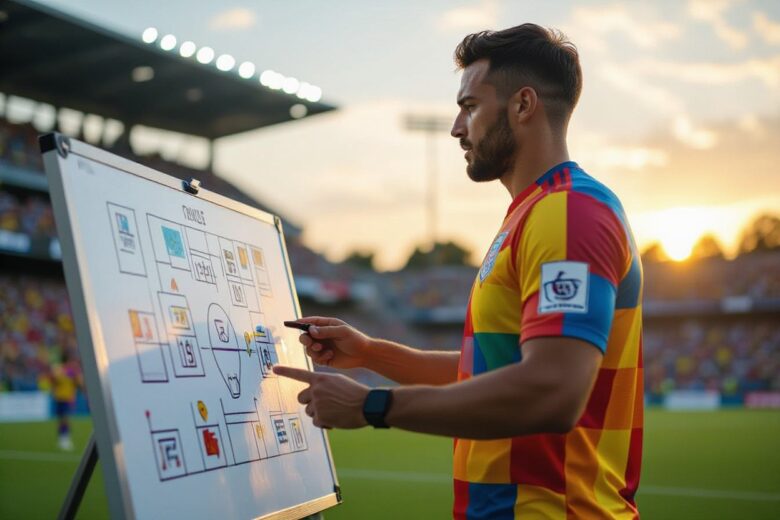Just when you think you understand football leadership, tactical captains reveal a deeper layer of the beautiful game. These field generals do far more than wear an armband – they serve as your team’s on-field strategist and decision-maker. While traditional captains inspire through emotion and leadership, tactical captains organize gameplay, adjust formations, and execute the manager’s vision in real-time. You’ll find these masterminds reading the game, directing teammates, and making split-second tactical adjustments that can mean the difference between victory and defeat.
The Tactical Captain’s Influence on Game Flow
Tactical captains read the game’s rhythms like master conductors, making split-second adjustments that shape match outcomes. Their ability to recognize pressing triggers and tactical patterns allows them to reorganize formations mid-game. Look at how Roy Keane would shift Manchester United’s midfield shape based on opponent movements, or how Sergio Busquets orchestrates Barcelona’s pressing intensity depending on ball position. These real-time decisions often determine whether your team maintains control or surrenders momentum.
The Bridge Between Coach and Players
Your tactical captain serves as the on-field extension of the manager’s vision, translating complex strategies into actionable directives. They process coaching instructions and communicate adjustments to teammates in real-time, ensuring tactical cohesion during high-pressure moments. Think of Paolo Maldini’s legendary communication at AC Milan, where his tactical awareness helped implement Arrigo Sacchi’s revolutionary zonal marking system.
The tactical captain’s role extends beyond simple instruction relay. They must gauge team energy levels, identify opposition weaknesses, and make autonomous decisions when communication with the bench becomes impossible. Studies show teams with strong tactical captains maintain formation discipline 23% better during crucial match phases. Your captain’s ability to read player positioning, anticipate tactical shifts, and implement counter-strategies often determines whether carefully planned training ground routines translate into match-day success.
Navigating Pressure: The Tactical Captain in High-Stakes Situations
Tactical captains face their ultimate test during high-pressure moments that can define seasons. Whether adjusting formations in the final minutes of a championship match or reorganizing the defense during a crucial penalty shootout, these leaders must maintain clarity while chaos swirls around them. Their ability to read the game and make split-second decisions often determines the outcome of pivotal matches.
Key Moments Where Tactical Leadership Shines
Your tactical captain becomes most valuable during specific game-changing scenarios: defending a one-goal lead in the final minutes, reorganizing after a red card, or adapting to unexpected opponent formations. Champions League finals have shown how tactical captains like Sergio Ramos and Paolo Maldini transformed defensive structures mid-game, turning potential defeats into historic victories through their on-field leadership and tactical awareness.
The Mental Fortitude Necessary to Guide a Team
Mental strength separates great tactical captains from good ones. Your captain must maintain composure while processing multiple tactical variables under intense pressure. They balance emotional support for teammates with clear, tactical direction – a dual role that demands exceptional psychological resilience.
The psychological demands on tactical captains extend beyond game day. They must analyze opponent patterns, anticipate strategic shifts, and maintain team cohesion through challenging periods. Studies show that teams with mentally resilient captains are 40% more likely to maintain tactical discipline in high-pressure situations. Your captain’s ability to stay focused while managing team dynamics creates a ripple effect, elevating the entire squad’s performance under pressure.
Communication Strategies of Tactical Captains
Tactical captains leverage both verbal and non-verbal communication to orchestrate their team’s movements during high-pressure matches. Through carefully developed signals, vocal commands, and strategic timeouts, these leaders maintain constant contact with teammates while adapting to rapidly changing game situations.
The Art of Non-Verbal Cues in Team Dynamics
Hand signals, eye contact, and body positioning form the foundation of split-second tactical adjustments during play. Your tactical captain might point to spaces, gesture defensive formations, or use pre-arranged signals to trigger set plays. Real Madrid’s Sergio Ramos exemplified this mastery, using subtle head movements and hand positions to reorganize his defensive line without alerting opposing strikers to tactical shifts.
Crafting Strategic Dialogue During Matches
Effective tactical captains master the balance between motivation and instruction, delivering clear, concise commands that cut through stadium noise. You’ll notice them using short, powerful phrases during set pieces, quick transitions, and defensive reorganizations. Liverpool’s Jordan Henderson demonstrates this skill by combining encouraging shouts with specific positional instructions to maintain tactical discipline.
These on-field conversations extend beyond simple directives – tactical captains read the game’s emotional temperature and adjust their communication style accordingly. During high-pressure moments, they might switch to short, sharp commands that demand immediate action, while calmer periods allow for more detailed tactical discussions with specific players. Your captain’s ability to modulate their voice, timing, and message content can mean the difference between maintaining formation and tactical breakdown.
The Evolution of the Tactical Captain Role
Historical Shifts in Responsibilities and Perceptions
The tactical captain’s role transformed dramatically from the 1960s onwards, shifting from purely motivational leadership to strategic on-field management. Players like Franz Beckenbauer revolutionized the position by combining technical excellence with tactical awareness, creating a new breed of captain who could both execute and adjust strategies mid-game. This evolution mirrored football’s increasing complexity, as captains became extensions of their managers on the pitch.
Future Trends: The Rise of Data-Driven Tactics
Modern tactical captains now integrate real-time analytics and performance metrics into their decision-making process. You’ll find captains wearing GPS tracking devices and receiving instant statistical feedback during matches. This technological integration allows for more precise tactical adjustments and player positioning, transforming how captains guide their teams through different game phases.
The data revolution has equipped tactical captains with unprecedented tools for success. Your captain now has access to heat maps showing team movement patterns, passing networks, and opposition weak points through tablet devices during breaks. Advanced metrics like expected goals (xG) and pressing intensity inform split-second decisions. Leading clubs like Liverpool and Manchester City have pioneered this approach, with their captains receiving specialized training in data interpretation and tactical software usage.
Learning from the Legends: Case Studies of Successful Tactical Captains
- Franz Beckenbauer – Led Germany to World Cup victory in 1974, with 103 caps and revolutionized the sweeper position
- Paolo Maldini – 902 appearances for AC Milan, orchestrated 5 Champions League victories with 88% successful defensive actions
- Roy Keane – Manchester United’s driving force in 366 matches, achieving 77% win rate as captain during the treble-winning season
- Carles Puyol – Barcelona captain for 10 years, maintained 75% tackle success rate while leading team to 6 La Liga titles
Analyzing Iconic Tactical Decisions
These legendary captains shaped matches through split-second decisions. Beckenbauer’s fluid transitions between defense and midfield created the modern ball-playing defender. Maldini’s defensive positioning revolutionized the left-back role, while Keane’s pressing triggers transformed how teams approached midfield battles. Their on-field adjustments often came without manager input, demonstrating pure tactical intelligence.
What Today’s Players Can Learn from Past Greats
Modern captains can adopt these legends’ approaches to reading game patterns and anticipating tactical shifts. Your ability to organize defensive lines, coordinate pressing movements, and adjust formations mid-game stems from studying these pioneers. Their methods of non-verbal communication and positional awareness remain relevant in today’s fast-paced game.
By analyzing match footage of these tactical masters, you’ll notice how they controlled tempo through subtle positioning changes. Puyol’s defensive organization during Barcelona’s high-pressing system showcases perfect examples of modern tactical leadership. These legends proved that effective captaincy combines instinctive decision-making with calculated risk-taking, creating a blueprint for contemporary leaders to follow.
Conclusion
To wrap up, when you examine football’s most successful teams, you’ll find tactical captains serving as the backbone of their triumphs. These on-field strategists enhance your team’s performance by coordinating movements, maintaining formation discipline, and adapting to changing game scenarios. As you develop your understanding of football leadership, you’ll recognize how these captains act as an extension of the coaching staff, translating tactical instructions into actionable plays. Their ability to read the game and guide teammates makes them invaluable assets in modern football’s complex tactical landscape.




